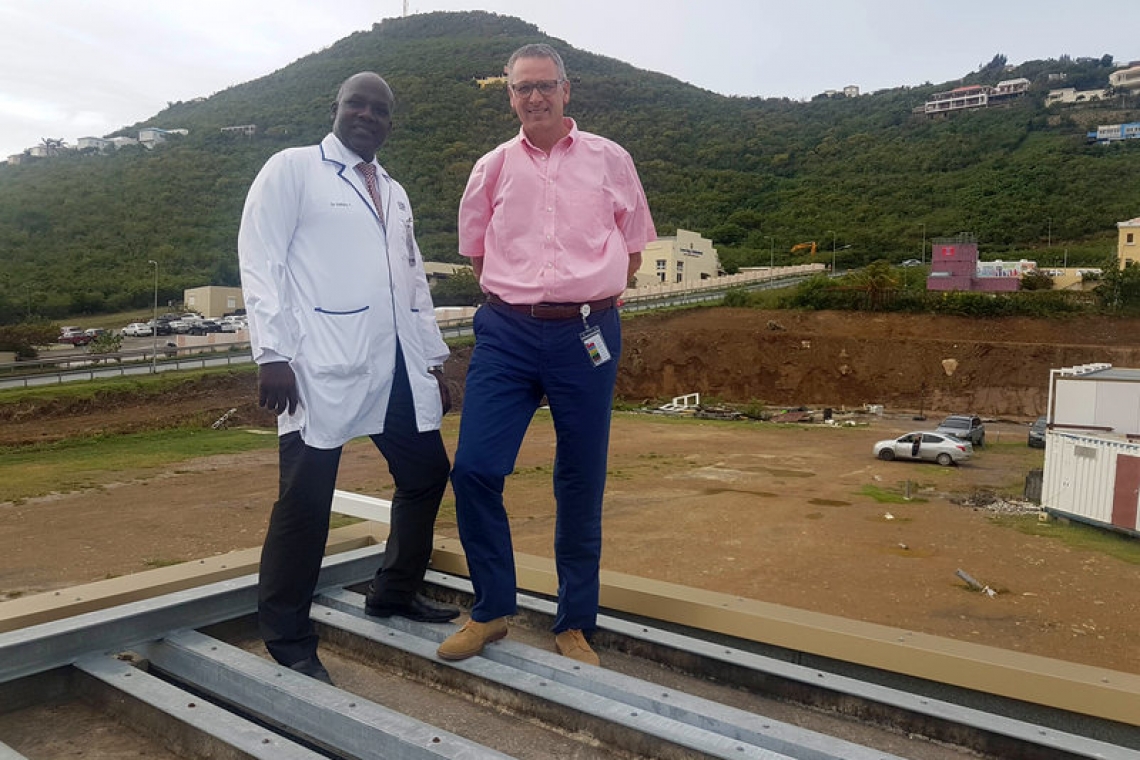From left: SMMC Medical Director Dr. Felix Holiday and Board of Directors Chairman Kees Klarenbeek.
CAY HILL--In an interview with The Daily Herald on Monday, the directors of St. Maarten Medical Center (SMMC) provided insight into the developments of the St. Maarten General Hospital (SMGH) project and updates on SMMC’s current plans.
Construction on the new hospital building started on Friday, January 17. Board of Directors Chairman Kees Klarenbeek told this newspaper that plans are “on track.” He said the new SMGH will have a capacity of 110 beds, an increase of almost 40 beds in comparison to SMMC’s current capacity.
“The current building is short on space, far too small and no longer suitable for the modern vision on healthcare anymore,” Klarenbeek said.
He said SMMC is the main hospital for St. Maarten and neighbouring islands, primarily Saba and St. Eustatius. One of its main goals was to increase the services provided for the population based on their specific care demand and to further reduce the number of medical referrals abroad.
Klarenbeek said the hospital had been able to reduce the number of patients sent abroad for treatment in the past five years. Within the five-year period 2015-2020, SMMC was able to reduce the number from 5,800 to around 2,000 referrals per year.
“We will decrease that number even further,” he said. “We don’t know yet what the exact number will be, but we do expect it will be far beneath 1,000 referrals per year.”
Klarenbeek said drastically reducing the number of patients referred abroad essentially means that “more money remains within our economy.”
In the interview Klarenbeek also addressed concerns about the increase in the tariffs. He said the previous tariffs were far too low and had not been adjusted since 2004, meaning a tariff adjustment was not done for 15 years, creating the need for the hospital to develop a new tariff system based on actual cost.
According to Klarenbeek, “New tariffs had to be set to at least the level of the cost price, and a little bit above. Cost for healthcare globally rose every year since 2004 as seen in the healthcare index. However, we did not use this index to set our tariff adjustments, because otherwise the tariff adjustment would have been much higher. To the contrary, we used a cost-price basis for the tariff adjustment.”
The tariff increase was seen as necessary as the hospital continues to expand its services and invest in newer, modern technology to be able to service the care demand in St. Maarten and surrounding islands.
Klarenbeek said the hospital’s budget had been raised to achieve this. He said when comparing the cost of payments made to outside sources (through referrals) it is far more favourable for St. Maarten cost-wise with the current tariff increase. “Payments made for outside referrals were far larger than what is now being spent on the tariff increase for SMMC,” Klarenbeek said. He added that the current system is “working perfectly fine.”
Klarenbeek noted that as the number of patients increases, so will the number of employees, for the hospital to be able to continue providing quality service, which positively contributes to employment in St. Maarten. He said the hospital has been able to increase the number of employees by a total 150 persons since 2015. “And this number will continue to grow,” he said.
The hospital currently employs approximately 300 people. This number will eventually increase to approximately 400.
The hospital has introduced several new medical specialities in recent years, including ophthalmology, neurology, pulmonology, urology and orthopaedics. Klarenbeek assured that the hospital had taken into account the current needs within the population. Based on the demand for patient care within the different specialities, the hospital constructed a model to evaluate those needs.
In the results of this model it was determined what the hospital needed as far as specialties and the number of medical specialists is concerned. Klarenbeek said, “This method was used to keep cost as reasonable as possible with the best positive economic impact for the country.”
He also addressed a transitional plan for employees of SMMC. He said a plan that will include all current employees at the hospital is currently in development. According to him, SMMC employees will be provided with a chance to further develop themselves through higher education opportunities.
Klarenbeek said this project would take years to complete through the use of a step-by-step approach. The organisation hopes the improvement of employee service will further improve the overall quality provided by SMMC.
Klarenbeek also said the hospital is currently working towards attaining accreditation from Joint Commission International (JCI), an independent organisation based in the United States that accredits healthcare organisations and programmes worldwide. He said, “JCI is an accreditation that will prove to the outside world that we are really a quality organisation.”
However, he noted that accreditation can only be acquired a year after the hospital has moved into the new building, as the new hospital building is part of the overall audit done by JCI on the quality of care.
He explained, “This is because you have to prove [to JCI – Ed.] in the new environment that you are performing based on all the quality standards of the JCI.”
According to Klarenbeek, SMMC has started preparations for this process through the development of a Quality and Safety Department.







